Welcome to Jain Irrigation Systems Ltd.

Blog at Jains - Research Article HOW MUCH WATER DOES MY CROP NEED?
Abstract: Along with provision of drip irrigation systems for various crops farmers are given scientifically estimated irrigation schedules. A tabulation of daily water requirement of the crop is a must for proper implementation of drip systems. In projects, a matching of land area that can be cultivated and volume of water available in the water source is to be done at the beginning of the projects. Farmers, when they began understanding that irrigation is based on crop water requirement and not total water available in the well start asking the above question. Hence the estimations are done based on the crop chosen and the evaporation of the location.
Keywords: Water management, Drip irrigation, Evapotranspiration, Crop water requirement
Citation: P. Soman (2020) How Much Water Does My Crop Need? International Journal of Agriculture Sciences, ISSN: 0975-3710 & E-ISSN: 0975-9107, Volume 12, Issue 23, pp.- 10430-10433.
Copyright: : Copyright©2020 P. Soman, This is an open-access article distributed under the terms of the Creative Commons Attribution License, which permits
unrestricted use, distribution and reproduction in any medium, provided the original author and source are credited.
Academic Editor / Reviewer: Dr Vijay Prajapati, Dr Zheko Radev, Dr Vipul N Kapadia
Introduction
The question, how much water does my crop need? is getting more intense and raised more often as the scarcity for water increases. Historically, the query was never raised in the past, as no one doubted about the availability of water. "It is always there" so why bother to ask at all. In the changing scenario, where water resources are no more available to use it as we wish, humans started measuring, estimating, and looking for opportunities to improve water productivity, conserve water or reduce its consumption. This change has come into the crop agriculture also.
Where does all the water go after one irrigates a crop field?
In precision irrigation the water given would only be equal to the sum of Transpiration (which increases as the crop grows and the canopy becomes large) and evaporation from exposed soil surface (which decreases as the crop cover increases). The goal of precision irrigation is to reduce the second component of water loss, surface evaporation. In conventional irrigation major part of water loss is not these two essential sinks but the rest (red in the photo). The water requirements of the crop equivalent to its ETP can be applied to precision only through drip method. In conventional method water is applied till the field is filled up with water and therefore the components of water loss (in red) remove a major portion of the applied water from the field. This fraction of water is actually wasted and not used by the crop resulting in very low water use efficiency and water productivity.
Material and Methods
When a farmer asks the question, how much does my crop need? The answer should be the ETP (evaporation plus transpiration) only. Accordingly, estimation of the water required for a good high yielding crop is made from the ETo published for the various locations, mostly for the district (source –Met data of India Water Portal). Daily ETo values were averaged over a month and WR for a month is estimated using the mean daily ETo. The difference in Water requirement among the districts is due to difference in evaporation rate during the growing season of the crop. ETP is estimated from ETo using crop factor (age), canopy factor (size) of the crop and efficiency factor of drip irrigation method (0.9). Water requirement is estimated for drip method as it is known as the most efficient method of precision irrigation available to us at present. For the first part of this exercise, water requirement of 10 seasonal crops grown in India are considered.
Sugarcane
How Much water I need for sugarcane crop?
For a 12 months crop duration, sugarcane requires only 14660 m3 to 15580 m3 water per hectare to produce 150 -250 t/ha yield under drip -fertigation assisted precision farming in the central and south peninsular India. Its requirement is 9680 m3 in north temperate region where low temperature restricts growth for 3-4 months. In this region the productivity is also comparatively low, 150-175 t/ha. Applying water as per the estimates above is possible only through drip method of irrigation. In conventional irrigation system the whole season consumes 25000 m3 on average in all these regions and the productivity of sugarcane ranged from 70- 87 t/ha only [Table-1]

Banana
For a 12 months period, Banana requires only 8663 m3 to 16210 m3 water per hectare to produce 85 -105 t/ha yield under drip -fertigation assisted precision farming in the central and south peninsular locations of India. Its requirement is 7456 m3 in north temperate region where low temperature affects growth rate to decrease for a period of 4 months. In this region the productivity is also - comparatively low, 78-85 t/ha. In conventional irrigation system the whole season consumes 19000- 22000 m3 in all these regions and the productivity of Banana ranged from 40-52 t/ha only [Table-2].

Cotton
For a 5 months period, Cotton requires only 3121m3 to 5010 m3 water per hectare to produce 6.25 t/ha yield (kapas) under drip -fertigation assisted precision farming. Applying water as per the estimates above is possible only through drip method of irrigation. In central India, Cotton is allowed to continue to grow and yield extra flushes of kapas. In such cases the water requirement exceeds the figures mentioned above because of the extended growth duration. Extended cotton crop requires 8864 m3/ha. In conventional irrigation system the whole season (5 months) consumes 11250 m3 in all these regions and the productivity ranged from 2.0- 2.5 t/ha only [Table-3].

Rice
Precision wetting of the soil is maintained in irrigation for Rice through drip method. In conventional method water is applied till the field is flooded to a height of 8-10 cm. Therefore, a major portion of the applied water moves away from the field and the crop does not use it. This fraction of water is actually wasted and not used by the crop resulting in very low water use efficiency and water productivity. Over a period, last 14 years I have proved that as for water utilisation for growth and productivity rice crop is not different from any other crop-like wheat, maize or pulses. This is contrary to the general perception of rice crop [Table-4].
For a 110 to 120 day growing period, rice requires only 3694 m3 to 6166 m3 water per hectare to produce 5-7 t/ha yield (harvested paddy grain) under drip - fertigation assisted precision farming. Applying water as per the estimates above is possible only through drip method of irrigation. In conventional irrigation system the whole season consumes an average of 23750 m3 in all the above regions and the average productivity recorded ranged from 2.0- 2.5 t/ha only in farmers field, though research station yields under conventional irrigation reaches up to 4-5 t/ha.
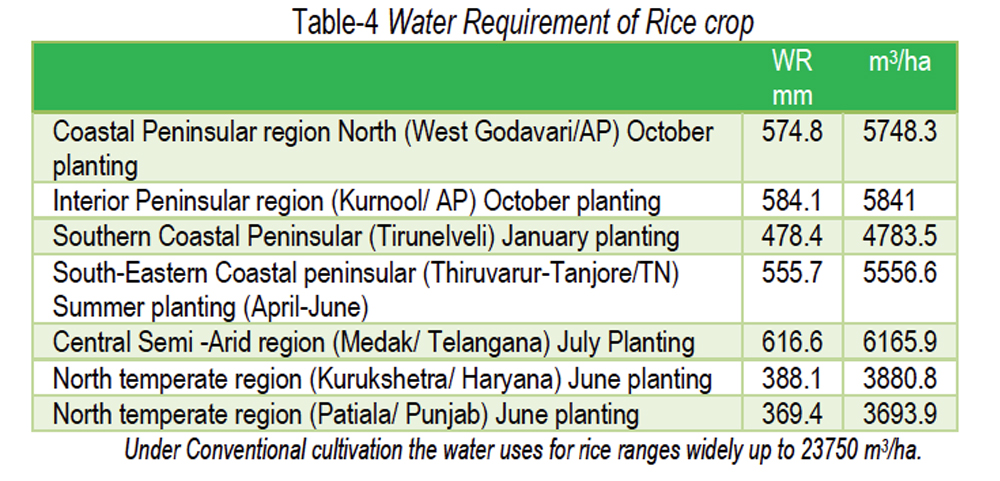
Wheat
Precision Irrigation in wheat is maintained by drip method of irrigation. In conventional method water is applied till the field/or field channels are filled up. In many fields in Haryana and Punjab one can see wheat crop standing in flood water due to excess irrigation water. A major portion of this applied water moves away from the field.
Though there are very vague recommendations, 7 or 8 irrigations of average 6 cm each in Punjab and 4-5 irrigations of 6 cm in Haryana for conventional irrigation application, farmers usually apply up to 10 cm or more per irrigation and irrigate up to 8 times during the season. Thus, a large volume of water is actually wasted every time the field is irrigated resulting in very low water use efficiency and water productivity of wheat.
For a 4 months period, Wheat requires only 2731 m3 to 3760m3 water per hectare to produce 5.9 to 6.64 t/ha yield under drip -fertigation assisted precision farming. In conventional irrigation system the whole season (4 months) consumes 8000 m3 on an average considering the way farmers apply irrigation water and the productivity of wheat ranged from 4.5 to 5.1 t/ha [Table-5].

Maize
Precision Irrigation in Maize is maintained by drip method of irrigation. In many fields in Haryana, Punjab and one can see maize crop with standing water due to excess irrigation water. A major portion of this applied water moves away from the field. For a growth 115 days period, Maize requires only 3642 m3 to 4342 m3 water per hectare to produce 10.0 to 12 t/ha yield under drip -fertigation assisted precision farming. In conventional irrigation system the whole season (115-120 days) consumes 5000-6000 m3 on an average considering the way farmers apply irrigation water and the productivity of ranged from 7- 8.5 t/ha [Table-6].
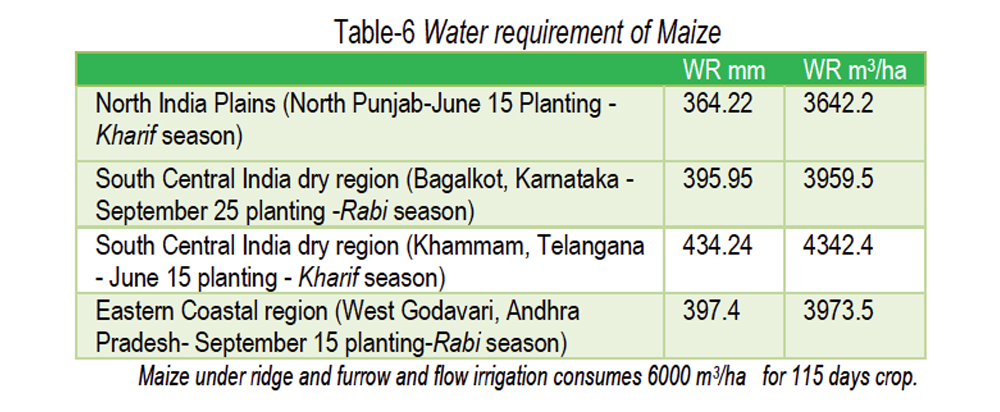
Potato
Precision wetting of the soil is maintained for Potato through drip method as against in conventional method where water is applied till all furrows are filled up. Therefore, a major portion of the applied water moves away from the field and the crop does not use it. This fraction of water is actually wasted.
For a 120 to 150 day growing period, Potato requires 1161- 6408 m3 water per hectare based on the evaporation rate of different locations. Yield under drip - fertigation assisted precision farming vary from 28-30 t/ha. Applying water as per the estimates above is possible only through drip method of irrigation. For Banaskantha, Gujarat where sprinkler method is more popular among the farmers, the water use would be higher, 5236 m3/ha (and thru drip it would be only 3490 m3/ha). The difference is not related to the crop but only to the application method. Sprinkler is less efficient (60%) while drip method has an efficiency of 90%. In conventional irrigation with flow in furrows, the whole season consumes an average of 7000 m3 in all the above regions and the average productivity recorded ranged from 16-18 t/ha only in farmer’s field [Table-7].
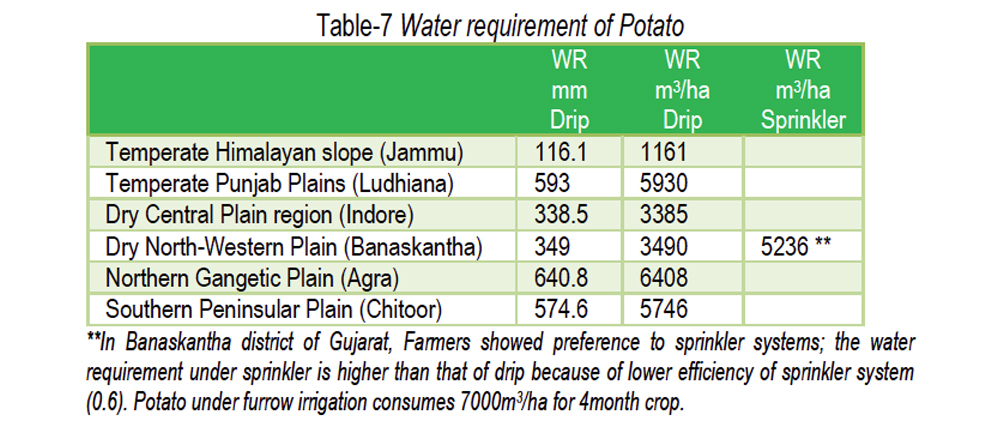
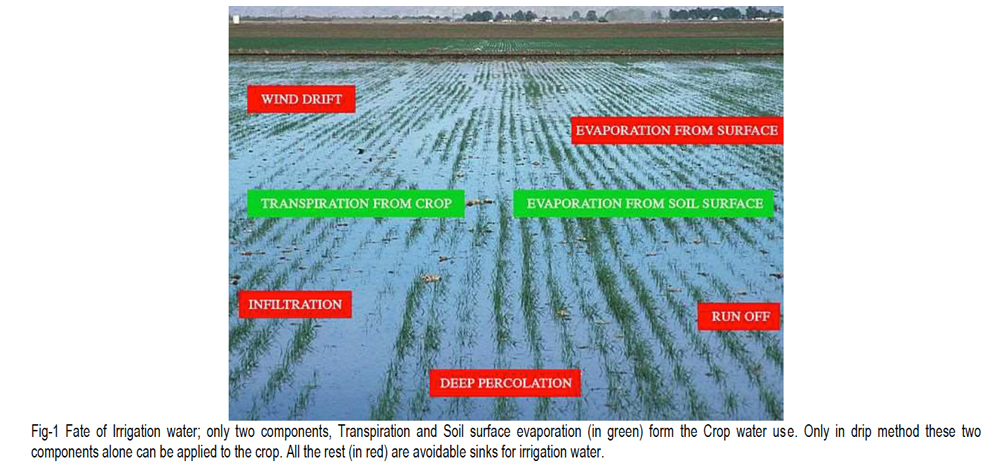

Tomato
Precision Irrigation and fertigation in Tomato is maintained by drip method of irrigation. In the open field, for a growth of 120 days period, Tomato requires 5000- 5170 m3 water per hectare (Kharif), 3750 m3- 5382 m3 (Rabi) and 7125 m3/ha (Summer) to produce a yield up to 50-60 t/ha yield under drip -fertigation assisted precision farming. The seasonal difference in water need of the crop is clearly demonstrated by the three seasons in Chitoor, Andhra Pradesh. It is the same variety of tomato in all three seasons and similar field conditions; but the ETP is different in Kharif, Rabi and Summer seasons. The crop water requirements are 5170 m3 in Kharif, 5382 m3 in Rabi and 7125 m3 in Summer. Applying water as per the estimates above is possible only through drip method of irrigation. In conventional irrigation system the whole season (115-120 days) consumes 7000-8000 m3 on an average considering the way farmers apply irrigation water and the productivity is around 25 t/ha [Table-8].
Turmeric
Precision Irrigation and fertigation in Turmeric is maintained by drip method of irrigation. In the field, for a growth period of 220 days, Turmeric needs 6000- 6900 m3 water per hectare and produces a yield up to 13.5 t/ha of dry Turmeric under drip -fertigation assisted precision farming. Applying water as per the estimates above is possible only through drip method. In conventional irrigation system the whole season (180-220 days) consumes more than 10,000 m3 on an average, considering the way farmers apply irrigation water and the productivity is around 6.3 t/ha dry Turmeric [Table-9].
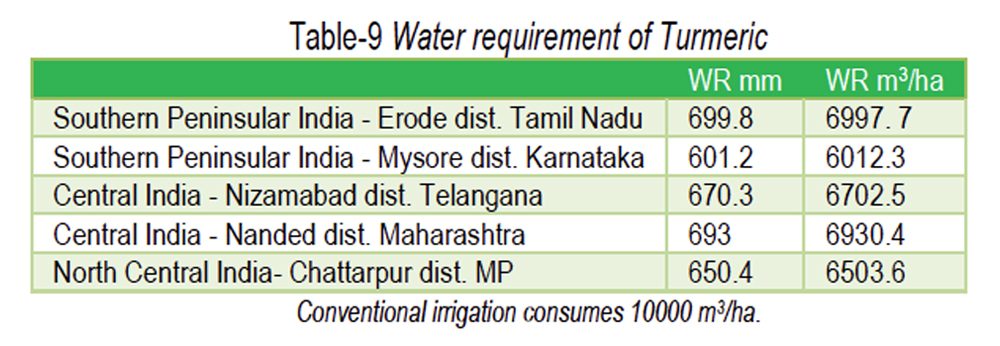
Watermelon
Precision Irrigation and fertigation for Watermelon is maintained by drip method of irrigation. In the field, for a growth period of 75-80 days, watermelon needs 3400- 4600m3 water per hectare and produces a yield up to 50 t/ha of fruits under drip - fertigation assisted precision farming. Applying water as per the estimates above is possible only through drip method of irrigation. In conventional irrigation system the whole season consumes more than 8000 m3 on an average, considering the way farmers apply irrigation water and the productivity is 24 t/ha [Table-10].
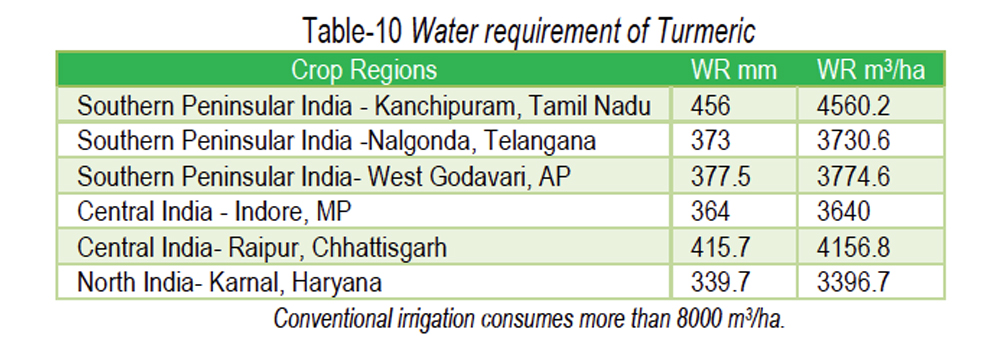
Conclusion
In all the above ten cases, precision irrigation at ETP through drip system meets the water demand of each crop fully and yields high. Conventional flood/furrow irrigation consumes more water and yields low. Therefore, drip method of irrigation gives out highest water productivity of these crops. This analysis also helps planners of irrigation projects in different parts of the country and may act as a revised guide for water allocations.
Application of research
Precision irrigation of crops is possible with drip technology. It is made possible by preparing an irrigation schedule using the reference evapotranspiration of the location. This estimated schedule is given to farmers and advise them to follow during their crop cycle. The paper has a direct application in crop growing.
Research Category: Water management, Drip irrigation
Abbreviations: ETP = Evapotranspiration, ETo = Reference evapotranspiration, WR = Water Requirement
**Principal Investigator or Chairperson of research: P. Soman
Institute: Jain Irrigation Systems Ltd., Jalgaon, 425001, Maharashtra, India
Research project name or number: Research station study
Author Contributions: Sole author
Author statement: Author read, reviewed, agreed and approved the final manuscript. Note-Author agreed that- Written informed consent was obtained from all participants prior to publish / enrolment
Study area / Sample Collection: Jain Irrigation Systems Ltd., Jalgaon, 425001, Maharashtra, India
Cultivar / Variety / Breed name: Sugarcane, Banana, Cotton, Rice, Wheat, Maize, Potato, Tomato, Turmeric, Watermelon
Conflict of Interest: None declared
Ethical approval: This article does not contain any studies with human participants or animals performed by any of the authors. Ethical Committee Approval Number: Nil
References
[1] India Water Portal website: For ETo Data
[2] Chapagain A.K. and Hoekstra A.Y. (2004) Appendix VI, Water
Footprints of Nations. Volume 2. Appendices. Research report Series
no.16. UNESCO-IHE.
Source :https://bioinfopublication.org/pages/jouarchive.php?id=BPJ0000217


